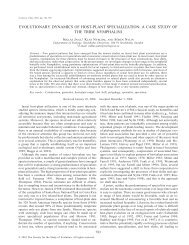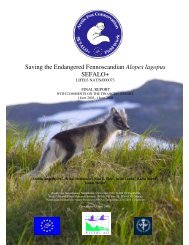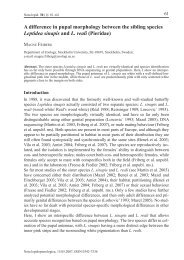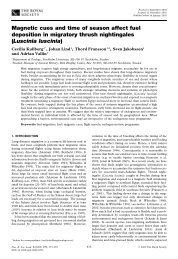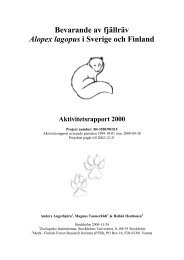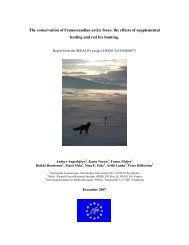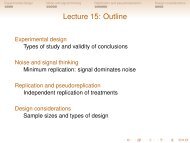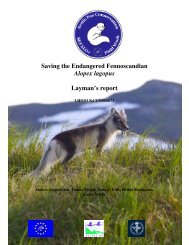Evolution of Fighting Behaviour: The Effect of Variation in Resource ...
Evolution of Fighting Behaviour: The Effect of Variation in Resource ...
Evolution of Fighting Behaviour: The Effect of Variation in Resource ...
Create successful ePaper yourself
Turn your PDF publications into a flip-book with our unique Google optimized e-Paper software.
GAMES WITH VARIATION IN RESOURCE VALUE 193A numerical iteration is used to f<strong>in</strong>d ESS's for the game: start<strong>in</strong>g from an <strong>in</strong>itialstrategy, a sequence <strong>of</strong> best replies are computed until convergence to an ESS isobta<strong>in</strong>ed. More details on this procedure are given <strong>in</strong> Appendix C. <strong>The</strong> proceduredoes not guarantee that all ESS's for the game will be found, but ESS's hav<strong>in</strong>g alarge bas<strong>in</strong> <strong>of</strong> attraction can be found <strong>in</strong> this way, and such ESS's are the mostlikely ones to appear <strong>in</strong> evolution.<strong>The</strong> <strong>in</strong>formational situation with respect to subjective resource value del<strong>in</strong>eatedabove makes it possible to apply the theorem <strong>in</strong> Appendix B. Thus, if an ESSspecifies different local strategies for different subjective resource values, the probability<strong>of</strong> w<strong>in</strong>n<strong>in</strong>g and the cost <strong>of</strong> an <strong>in</strong>teraction will <strong>in</strong>crease with an <strong>in</strong>dividual'ssubjective resource value. For a sequential assessment game, it is possible to extendthis result somewhat. Consider the local strategies (switch<strong>in</strong>g l<strong>in</strong>es):-- ! ! . Sit ~ t! t/ .S'- (S,, S2,..), (Sl, S2,..).If S" < S~ for all n we say that S' is more persistent than S". Us<strong>in</strong>g the theorem <strong>in</strong>Appendix B one can show that if an ESS has the property that different localstrategies are used as subjective resource value varies, then progressively morepersistent local strategies will be used as subjective resource value <strong>in</strong>creases.First Example: Sequential Assessment Game With Random RewardsWe now consider contests between animals that vary <strong>in</strong> fight<strong>in</strong>g ability accord<strong>in</strong>gto some distribution and <strong>in</strong>dependently vary <strong>in</strong> subjective resource value accord<strong>in</strong>gto some other distribution. Two contest<strong>in</strong>g animals are to be <strong>in</strong>dependently drawnfrom these distributions. <strong>The</strong>re is no role asymmetry, and the only <strong>in</strong>formation an<strong>in</strong>dividual has about an opponent prior to an <strong>in</strong>teraction is that the opponent isdrawn from the above mentioned distributions. As a contest proceeds, an <strong>in</strong>dividualwill get <strong>in</strong>formation about the opponent's subjective resource value, but this <strong>in</strong>formationis assumed not to change the <strong>in</strong>dividual's own subjective resource value. Thiscontest situation might correspond to contests over food items with variation <strong>in</strong>subjective resource value be<strong>in</strong>g due to vary<strong>in</strong>g degrees <strong>of</strong> hunger.To give an example <strong>of</strong> an ESS for this situation, we have analysed a case with adiscrete distribution <strong>of</strong> subjective resource values with 11 classes rang<strong>in</strong>g fromV = 0-5 to V = 1.5 with <strong>in</strong>crement 0.1 and with the same relative frequency for eachclass. <strong>The</strong> prior distribution <strong>of</strong> relative fight<strong>in</strong>g ability (/3(0)) is normal with meanzero and standard deviation 0-5. <strong>The</strong> standard deviation <strong>of</strong> the sampl<strong>in</strong>g error (or)is put to 0-5 and the cost parameter (c) is 0.05. We have found only one ESS forthe game. This ESS is shown <strong>in</strong> Fig. 1 as switch<strong>in</strong>g l<strong>in</strong>es represent<strong>in</strong>g local strategiesfor each subjective resource value.Note from Fig. 1 that the local strategies have the property that the level (Sn)where one gives up becomes higher as n <strong>in</strong>creases; this is related to the fact that acontestant's estimate <strong>of</strong> relative fight<strong>in</strong>g ability becomes more accurate as the<strong>in</strong>teraction proceeds. It is also clear that animals with higher subjective resourcevalue are more persistent.



